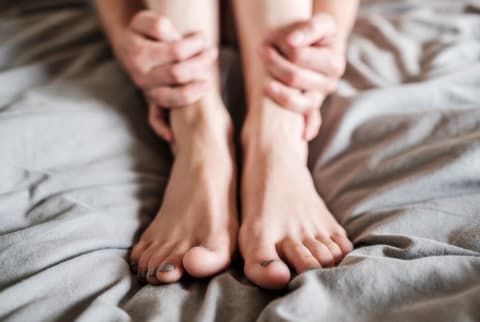Advertisement
How To Safely Remove Calluses At Home: 6 Steps To Butter-Soft Soles


Removing calluses is not only an aesthetic venture: While the rough, dry skin doesn't usually hurt, those calluses can crack when they're left untreated for too long—which means bacteria can easily sneak inside and cause irritation or infection down the line.
That said, it's important to slough off the dry skin from time to time. Not to mention, your soles will appear smooth and supple in the process, and who doesn't want that? But before you hack at them with nail scissors or peel off the dry skin (cue the collective shudder), here's exactly how experts recommend removing them safely at home:
First, soak your feet.
Soaking in water helps soften the thicker, coarser skin on the foot—which makes it easier to buff away calluses later on. So prior to any sort of exfoliating treatment, a nice footbath is key to help loosen the top layer of skin. Plus, as board-certified dermatologist Loretta Ciraldo, M.D., FAAD, tells us about lukewarm baths, soaking can actually swell up the surface area of the skin, which allows for more penetration of good-for-you ingredients (like creams and oils) later on.
Fill your tub or basin with lukewarm water for a simple soak, or feel free to chuck in some Epsom salts, oils, or gentle soaps for extra soothing benefits.
Use apple cider vinegar.
Due to apple cider vinegar's natural alpha-hydroxy acid properties1, an ACV foot soak can help slough off dead skin cells and encourage cell turnover. For those who want to gently exfoliate the calluses without reaching for a pumice stone or foot file (which we'll get into below), this type of footbath is just sublime.
Specifically, the solution contains "AHAs like lactic, citric, and malic acids," says board-certified dermatologist Keira Barr, M.D., which work to "exfoliate the uppermost layers of the skin, revealing skin that appears smoother and more hydrated." Consider it a one-step process to soft soles.
Try a foot scrub.
After your soak (unless you stick to ACV), many are quick to sing the praises of a gentle foot scrub. Better yet, you can concoct one in the comfort of your own kitchen. Ingredients like baking soda, coffee grounds, and brown sugar all make excellent physical exfoliators. Add a few extra skin-softening ingredients to the blend, and you've got yourself the perfect DIY scrub on your hands (or, uh, feet).
Scoop a dollop of your favorite foot scrub and rub in circular motions on those calluses until they're touchably soft.
Grab a pumice stone or buffer.
Pumice stones are beloved for sloughing off calluses with ease (if you don't have one at home, any foot file or buffer will do, says Gloria L. Williams, Oprah's pedicurist and founder of Footnanny). Rub the tool in circular motions—or back and forth, if you're using a foot file—over your calluses for two to three minutes until they're even and smooth.
Make sure to use it on clean, wet skin—the soak will loosen the thickened layer of skin and make it easier to buff the calluses smooth. Also, be sure to follow with a moisturizing foot cream: "Since the manual exfoliation of the stone can cause microabrasions on the skin, it's important to apply moisturizer to help repair the small cracks in the skin from the pumice exfoliation," explains board-certified dermatologist Purvisha Patel, M.D., and founder of Visha Skincare.
Apply a foot mask.
Of course, tackling calluses and cracks isn't just about exfoliating the skin smooth: You also need to focus on moisture to prevent the dryness in the first place. That's why your foot spa day should always feature some sort of hydrating step—say, a foot mask to provide a blanket of moisture.
Here's how to make one at home: After applying your favorite foot cream, cover your feet with some socks to "allow the cream to penetrate into your skin," says Williams. For the best results, wear the socks overnight and wake up to butter-soft soles.
Reminder: Do not cut or peel.
As tempting as it may be to peel away those rough patches of skin, tampering with your calluses is not (we repeat: not) a good idea. See, so long as you keep up your exfoliating-moisturizing regimen, those calluses should naturally flake off on their own. Tearing at the skin yourself can cause pain, discomfort, and even infection. Says Morgan Rabach, M.D., a board-certified dermatologist and co-founder of LM Medical in NYC, about flaking skin, "It's best to let the dead skin peel itself off naturally without pulling it, as you can tear further into the skin."
The takeaway.
Removing calluses at home requires some diligent foot care; to truly achieve crack-free soles, you'll need a healthy balance of exfoliation and moisture. Of course, you should always see a pedicurist or podiatrist if your calluses are extremely rough or painful—but for your run-of-the-mill upkeep, consider these your marching orders.